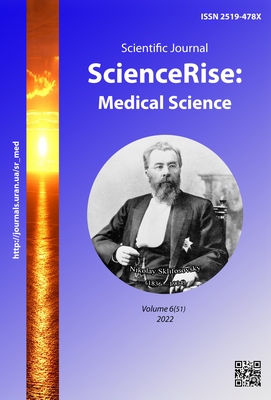High hCG levels as a cut-off to guide medical management of ectopic pregnancy: our experience
DOI:
https://doi.org/10.15587/2519-4798.2022.269499Keywords:
Ectopic pregnancy, Human chorionic gonadotropin (hCG), methotrexate, hemodynamically stableAbstract
The face is the most prominent part of the body. Facial blemishes and disorders directly reflect a person's physical appearance, cosmesis and self-image. They may contribute to dysmorphism and even lead to depression in susceptible individuals, especially women. Early identification and management of facial skin disorders are therefore important.
The aim: To study the clinical pattern and epidemiological determinants of facial dermatoses among females above 10 years.
Methods: The study was carried out at Mediciti Medical sciences from 2014 to 2017; institutional ethical clearance was obtained (dated 7/2//2015 with registration number FWA00002684)
A total of 500 female patients with facial dermatoses, aged 10 to 85 years, were enrolled in this cross-sectional study for 18 months. Detailed history and clinical examination findings were recorded in a structured proforma. Patients with sexually transmitted infections (STIs) were excluded. In addition, woods lamp examination, skin scrapings for potassium hydroxide mount, skin biopsy and other relevant investigations were done as required.
Results: A total of 500 patients were enrolled. The majority were in the 4th and 5th decades. Pigmentary dermatoses were highest, melasma predominating. Immunobullous dermatoses formed the smallest group. Occupation-wise, the majority were agricultural labourers. Many dermatoses, especially melasma, were related to occupation and lifestyle with photo-aggravation, cosmetics use and stress.
Conclusion: This study assessed the pattern of facial dermatoses among the female clientele of this institution. Hyperpigmentary dermatoses, especially melasma, emerged as the most common dermatosis for which treatment was sought. This study assessed the pattern and epidemiologic determinants of facial dermatoses in female patients in a rural Tertiary hospital at Ghanpur, Telangana. Melasma was the most frequent dermatosis for which treatment was sought. Larger population-based studies would determine the actual socioeconomic burden of the problem
References
- Verma, M., Singh, U., Solanki, V., Sachan, R., Sankhwar, P. (2022). Spectrum of Ectopic Pregnancies at a Tertiary Care Center of Northern India: A Retrospective Cross-sectional Study. Gynecology and Minimally Invasive Therapy, 11 (1), 36–40. doi: https://doi.org/10.4103/gmit.gmit_1_21
- Skubisz, M. M., Tong, S. (2012). The Evolution of Methotrexate as a Treatment for Ectopic Pregnancy and Gestational Trophoblastic Neoplasia: A Review. ISRN Obstetrics and Gynecology, 2012, 1–8. doi: https://doi.org/10.5402/2012/637094
- Celik, E., Turkcuoglu, I., Karaer, A., Kirici, P., Eraslan, S. (2013). Assessment of early decline in percentage of β-hCG values between days 0 and 4 after methotrexate therapy in ectopic pregnancy for prediction of treatment success. Journal of the Turkish German Gynecological Association, 14 (3), 125–129. doi: https://doi.org/10.5152/jtgga.2013.50133
- ACOG Practice Bulletin No. 191: Tubal Ectopic Pregnancy (2018). Obstetrics & Gynecology, 131 (2), e65–e77. doi: https://doi.org/10.1097/aog.0000000000002464
- Prabhakaran, M., Beesetty, A. (2021). Ectopic Pregnancy With Low Beta-Human Chorionic Gonadotropin (HCG) Managed With Methotrexate and Progressed to Rupture. Cureus, 13 (10). doi: https://doi.org/10.7759/cureus.18749
- Lipscomb, G., Ling, F. W. (2000). Predictors of Success of Methotrexate Treatment in Women with Tubal Ectopic Pregnancies. New England Journal of Medicine, 342 (15), 1138–1138. doi: https://doi.org/10.1056/nejm200004133421514
- Tenore, J. L. (2000). Ectopic pregnancy. American Family Physician, 15, 1080–1088.
- Corsan, G. H., Karacan, M., Qasim, S., Bohrer, M. K., Ransom, M. X., Kemmann, E. (1995). Identification of hormonal parameters for successful systemic single-dose methotrexate therapy in ectopic pregnancy. Human Reproduction, 10 (10), 2719–2722. doi: https://doi.org/10.1093/oxfordjournals.humrep.a135774
- Saxon, D., Falcone, T., Mascha, E., Marino, T., Yao, M., Tulandi, T. (1997). A study of ruptured tubal ectopic pregnancy. Obstetrics & Gynecology, 90 (1), 46–49. doi: https://doi.org/10.1016/s0029-7844(97)00180-4
- Menon, S., Colins, J., Barnhart, K. T. (2007). Establishing a human chorionic gonadotropin cutoff to guide methotrexate treatment of ectopic pregnancy: a systematic review. Fertility and Sterility, 87 (3), 481–484. doi: https://doi.org/10.1016/j.fertnstert.2006.10.007
- Nowak-Markwitz, E., Michalak, M., Olejnik, M., Spaczynski, M. (2009). Cutoff value of human chorionic gonadotropin in relation to the number of methotrexate cycles in the successful treatment of ectopic pregnancy. Fertility and Sterility, 92 (4), 1203–1207. doi: https://doi.org/10.1016/j.fertnstert.2008.07.1775
Downloads
Published
How to Cite
Issue
Section
License
Copyright (c) 2022 K. S. S. Madhavi, K. Avani Reddy

This work is licensed under a Creative Commons Attribution 4.0 International License.
Our journal abides by the Creative Commons CC BY copyright rights and permissions for open access journals.
Authors, who are published in this journal, agree to the following conditions:
1. The authors reserve the right to authorship of the work and pass the first publication right of this work to the journal under the terms of a Creative Commons CC BY, which allows others to freely distribute the published research with the obligatory reference to the authors of the original work and the first publication of the work in this journal.
2. The authors have the right to conclude separate supplement agreements that relate to non-exclusive work distribution in the form in which it has been published by the journal (for example, to upload the work to the online storage of the journal or publish it as part of a monograph), provided that the reference to the first publication of the work in this journal is included.









